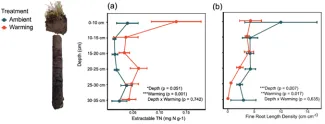Results from manipulative field experiment indicate that both nutrient availability and root traits shift rapidly in response to a single growing season of elevated temperature, but these changes did not result in faster plant nitrogen uptake.
Tundra ecosystems are experiencing rapid warming and more frequent temperature extremes: the three warmest years from 1900–2020 in the Arctic occurred in 2016, 2019, and 2020. Extreme heat events are expected to increase in frequency in the coming decades. The team simulated the impact of a single, hot growing season in Utqiaġvik, Alaska, by deploying zero-power warming chambers that increased average daily air temperatures by 3.2°C. The warming treatment elongated the period for which daily air temperatures were above zero by 11 days and was strong enough to affect soil temperatures down to 10 cm. To understand the influence of this intense heat on belowground dynamics, the team studied the above- and belowground response of a common Arctic grass, Arctagrostis latifolia. Biomass of A. latifolia did not increase with warming, but warming had a significant impact on carbon:nitrogen of developing tissues, fine root length, and fine root mass. Rates of NH4 uptake were not directly impacted by warming even though availability of both nitrogen and phosphorus increased dramatically in the soil profile. The fact that warming increased available nutrients in the soil, altered root traits, but failed to impact rates of NH4 uptake indicates an important shift in the relationship among these three belowground traits. When the kinetic relationship between NH4 uptake and availability was examined, the data did not fit a classic Michaelis–Menten equation that many models currently use to represent nutrient uptake. Instead, the results were best captured by spatially explicit units (uptake per meter of fine root and availability per cubic centimeter of soil) and a logistic curve. Predicting plant–soil interactions in nutrient-limited ecosystems like the tundra remains a challenge, especially since the results indicate that both nutrient availability and root traits can shift rapidly in response to a single growing season of elevated temperature.
Citation: Salmon, V. G., A. Rogers, J. Childs, K. Ely, S. Serbin, B. Spencer, K. Lewin, R. Norby, and C. M. Iversen. “One growing season of warming increases soil nutrient availability but not plant nitrogen uptake: insight into shifting belowground trait dynamics.” Submitted.
For more information, please contact:
Verity Salmon
salmonvg@ornl.gov

